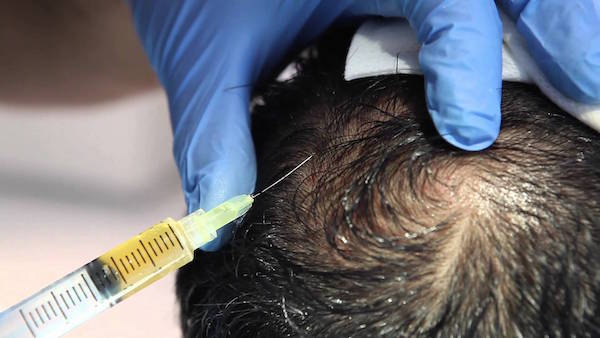PRP Hair Treatment Los Angeles
Platelet Rich Plasma (PRP) has been suggested in the past as a possible treatment for hair loss. Using growth factors as a means of restoring hair as well as preventing hair loss is an ongoing project in the field of hair restoration.
The PRP that is extracted from the blood of the patient contains proteins such as growth factors and is used as a potential hair restoration treatment by some centers.
PRP Explained

PRP is extracted from the non-cellular component of blood. PRP includes platelets and growth factors. The plasma extracted from a patient’s blood in an outpatient setting contains the following growth factors:
- Platelet-Derived Growth Factor (PDGF)
- Transforming Growth-Factor-Beta (TGF-b)
- Vascular Endothelial Growth Factor (VEGF)
- Epidermal Growth Factor (EGF)
- Fibroblast Growth Factor-2 (FGF-2)
- Insulin Like Growth Factor – (IGF)
These growth factors help with several stages of healing after a patient suffers from injuries or inflammatory conditions.
The presence of the above factors is the reason PRP injections have been linked to treating a variety of medical conditions by promoting tissue and organ healing as well as soft tissue inflammation tendon/fascia/muscles injuries. Since some of these growth factors are also involved in the growth of hair, it has been assumed that PRP could be used as an option to treat baldness.
PRP Preparation
Harvesting PRP is a simple process that involves collecting blood from a patient and separating the plasma from it by spinning it in a centrifuge device. The separation process splits the cellular elements inside the blood such as the RBCs (Red Blood Cells) and WBCs (White Blood Cells) from the plasma (liquid) part of the blood that has growth factors and platelets.
Most studies related to PRP hair treatment Los Angeles were done on a small number of patients with inconsistent results. Many clinicians use PRP by itself as regular injections to the scalp and some use it in conjunction with other hair loss treatments or medical treatments. The early studies on PRP were not substantiated enough to introduce PRP as an effective hair loss Los Angeles treatment with long lasting results, therefore we don’t perform PRP in our offices.
At John Hopkins Medical School, we were able to conduct a number of studies that used growth factors for wound healing. The issue with using the growth factors for wound healing, along with other purposes, is that these proteins are very labile and are removed from the tissue in just a few minutes. A continuous source of growth factors is needed in order to see any stimulating results on a cellular level that can support a sustaining growth. Our focus of studies at John Hopkins wound healing lab was to provide a more continuous source for growth factors that were needed to help wound healing. We have been able to do that in experimental levels through injecting the genes responsible for production of those growth factors to the skin cells. Creating such a mechanism in balding skin seems to be a more promising means of using growth factors for hair growth as well as for wound healing in the future.